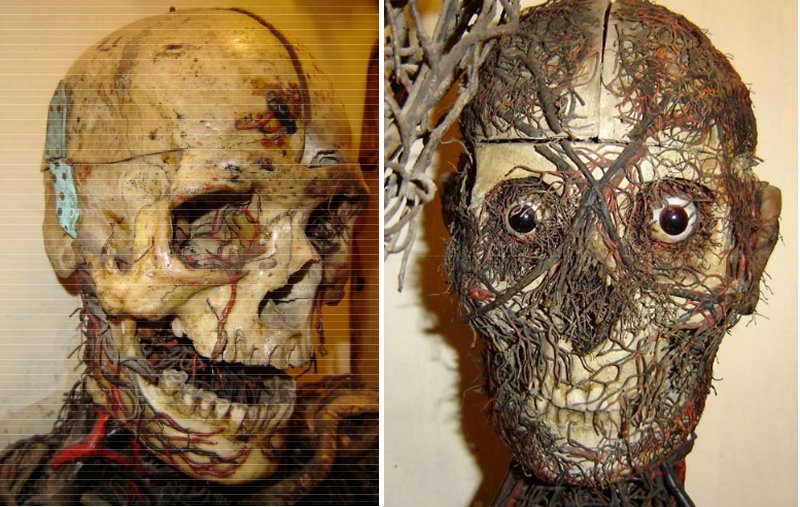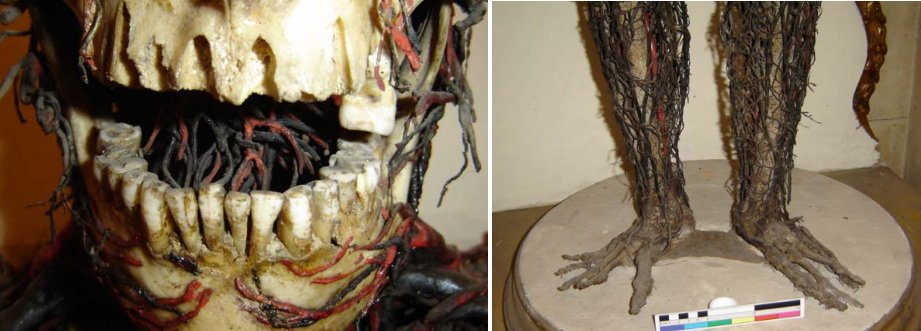Incredible Anatomical Human Machines – Two Fleshless Bodies Mystery
A. Sutherland - AncientPages.com - The so-called 'Anatomical Machines' are preserved in the underground crypt of the Sansevero Chapel, located in the historic center of Naples, Italy.
The 'Anatomical Machines' are the skeletons of a man and a woman in an upright position with the artery and vein systems almost perfectly intact.
Still today, after about two-and-a-half centuries, it remains a mystery what procedures and/or materials were used to obtain such exceptional preservation of the circulatory system.
Credit: Museo Cappella Sansevero
The 'Anatomical Machines' are the skeletons of a man and of a woman in the upright position with the artery and vein systems almost perfectly intact.
Stored in two glass cases, the pair represents one of the most impressive monuments that the human mind has ever conceived.
The 'Machines' were made by the doctor Giuseppe Salerno, an anatomist from Palermo, Italy under the direction of Raimondo di Sangro, Prince of Sansevero (1710-1771), alchemist and Grand Master of Neapolitan Masonic Lodge, philosopher, and poet, naturalist, and anatomist, astronomer, philanthropist.
 According to an anonymous document – the 'Short Note', which is considered a guide to the Palace and the Sansevero Chapel, a mysterious injection was involved in the procedure.
According to an anonymous document – the 'Short Note', which is considered a guide to the Palace and the Sansevero Chapel, a mysterious injection was involved in the procedure.
Was a technique known as 'anatomical injection of embalming substances', a part of this mysterious procedure?
It is said that Dr. Salerno injected a substance – perhaps based on mercury – into the two corpses.
The substance would have been created in a laboratory by the Prince of Sansevero and would allow the "metallization" of the blood vessels.
There is also another suggestion, namely, that the circulatory system was ingeniously reconstructed in these two amazing anatomical 'machines.'
In fact, the arteries and veins are reproduced with remarkable perfection, even the smallest vessels, even though knowledge of anatomy was not as precise as it is today.
In the 'Short Note', the 'machines' - kept in a room in the palace of the Prince of Sansevero, called "the Apartment of the Phoenix" – are described in detail.
Left: The crania were sawn open so that the complex network of blood vessels present in the cranial cavity could be inspected; Right: The outer surface of the female's cranium is covered with blood vessels. Credit: R. Peters - The American Institute for Conservation of Historic & Artistic WorksMuseo Cappella Sansevero
At the feet of the woman, the guide states, there was placed "the tiny body of a fetus", alongside which there was even the open placenta, connected to the fetus by the umbilical cord.
Some of the vital organs are present but also seem misplaced. Although the organs were not sampled, visual examination suggests that they may have been made with a wood core coated with wax.
Left: The male has only 16 teeth; some have longitudinal cracks; Right: The female is mounted onto a plinth, attached to it from the feet. Credit: R. Peters - The American Institute for Conservation of Historic & Artistic WorksMuseo Cappella Sansevero
The two anatomical studies were moved to the Chapel and saved from destruction or loss long after the death of the Prince.
The remains of the fetus were still visible up to a few decades ago until they were stolen. According to popular belief, Raimondo di Sangro "had two of his servants killed," a man and a woman, and embalmed their bodies.
In Greek mythology, Phoenix - a long-lived bird that is cyclically regenerated or reborn - is the associated with the myth of resurrection and immortality.
Was a technique known as 'anatomical injection of embalming substances' a part of this mysterious procedure? Credit: R. Peters - The American Institute for Conservation of Historic & Artistic WorksMuseo Cappella Sansevero
Were these fleshless bodies the objects of di Sangro's studies? He was often portrayed as a 'misunderstood man, ahead of his time.
Was the 'Apartment of the Phoenix' used intentionally, or was the name 'Phoenix' chosen accidentally?
These questions may seem rather difficult to answer. Due to the lack of written documentation on the early history of the anatomical machines, the mystery will probably never be solved.
Until recently, many Neapolitans believed that the models were of his servant and a pregnant woman, into whose veins an artificial substance was injected under pressure, but the latest research has shown that the models are artificial.
Credit: Museo Cappella Sansevero
No evidence indicated that the vessels of the cadavers used to make the 'human machines' were injected with embalming substances.
Di Sangro destroyed his own scientific archive before he died. After his death, his writings, formulae, laboratory equipment, and results of experiments were destroyed, probably under threat of ex-communication by the Church due to Di Sangro's involvement with Freemasonry and alchemy.
Updated on May 25, 2022
Written by – A. Sutherland AncientPages.com Senior Staff Writer
Copyright © AncientPages.com All rights reserved. This material may not be published, broadcast, rewritten or redistributed in whole or part without the express written permission of AncientPages.com
Expand for referencesMore From Ancient Pages
-
 Killer-Of-Enemies – Mysterious Non-Human Teacher And Hero Of The Apache Indians
Featured Stories | Nov 16, 2020
Killer-Of-Enemies – Mysterious Non-Human Teacher And Hero Of The Apache Indians
Featured Stories | Nov 16, 2020 -
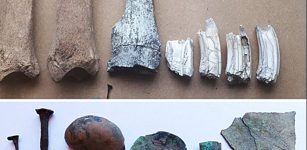 South American Cultures Quickly Adopted Horses – New Study
Archaeology | Dec 26, 2023
South American Cultures Quickly Adopted Horses – New Study
Archaeology | Dec 26, 2023 -
 6 Ancient Minorities That Intrigue Scientists
Civilizations | Feb 25, 2020
6 Ancient Minorities That Intrigue Scientists
Civilizations | Feb 25, 2020 -
 Unknown Ancient Structures Discovered At Machu Picchu By LIDAR
Archaeology | Mar 29, 2022
Unknown Ancient Structures Discovered At Machu Picchu By LIDAR
Archaeology | Mar 29, 2022 -
 Tetzacualco – Mesoamerican Mini Model Of The Universe Discovered Underwater
Archaeology | Jan 4, 2018
Tetzacualco – Mesoamerican Mini Model Of The Universe Discovered Underwater
Archaeology | Jan 4, 2018 -
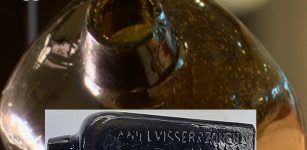 Message In A Bottle Thrown Overboard In Germany 132 Years Ago Was Found In Australia
Archaeology | Mar 8, 2018
Message In A Bottle Thrown Overboard In Germany 132 Years Ago Was Found In Australia
Archaeology | Mar 8, 2018 -
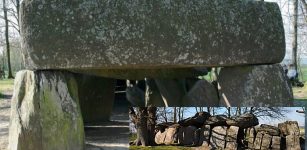 Mysterious Huge Neolithic Dolmen Roche-aux-Fées In Brittany Built By The Fairies As Legend Says
Featured Stories | Sep 25, 2022
Mysterious Huge Neolithic Dolmen Roche-aux-Fées In Brittany Built By The Fairies As Legend Says
Featured Stories | Sep 25, 2022 -
 On This Day In History: ‘Earl of Northumberland’ Thomas Percy Executed Because He Was Catholic – On August 22, 1572
News | Aug 22, 2016
On This Day In History: ‘Earl of Northumberland’ Thomas Percy Executed Because He Was Catholic – On August 22, 1572
News | Aug 22, 2016 -
 On This Day In History: Universal Declaration Of Human Rights Adopted – On Dec 10, 1948
News | Dec 9, 2016
On This Day In History: Universal Declaration Of Human Rights Adopted – On Dec 10, 1948
News | Dec 9, 2016 -
 Scotland’s Mysterious Ballachulish Figure Could Be Cailleach Bheithir – Ancient Hag Goddess Of Winds And Storms
Artifacts | Nov 23, 2018
Scotland’s Mysterious Ballachulish Figure Could Be Cailleach Bheithir – Ancient Hag Goddess Of Winds And Storms
Artifacts | Nov 23, 2018 -
 On This Day In History: Terrible Day In Moscow Engulfed By Fire – On June 21, 1547
News | Jun 20, 2016
On This Day In History: Terrible Day In Moscow Engulfed By Fire – On June 21, 1547
News | Jun 20, 2016 -
 Yakhchals: Ingenious Ancient ‘Refrigerators’ Could Store Ice In The Hot Desert
Ancient Technology | Sep 15, 2018
Yakhchals: Ingenious Ancient ‘Refrigerators’ Could Store Ice In The Hot Desert
Ancient Technology | Sep 15, 2018 -
 Magnificent Trumpington Cross And Highly Unusual Anglo-Saxon ‘Bed Burial’ In Cambridge Offer Unique Insight Into English Christianity
Archaeology | Feb 22, 2018
Magnificent Trumpington Cross And Highly Unusual Anglo-Saxon ‘Bed Burial’ In Cambridge Offer Unique Insight Into English Christianity
Archaeology | Feb 22, 2018 -
 Irkalla – Underworld With No Return Ruled By Ereshkigal, Granddaughter Of Enlil And Sister Of Inanna
Featured Stories | Oct 20, 2021
Irkalla – Underworld With No Return Ruled By Ereshkigal, Granddaughter Of Enlil And Sister Of Inanna
Featured Stories | Oct 20, 2021 -
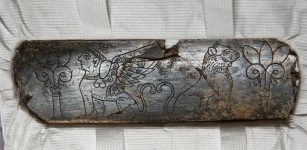 Unique 2,800-Year-Old Ivory Object Unearthed At Hattusa
Archaeology | Nov 14, 2023
Unique 2,800-Year-Old Ivory Object Unearthed At Hattusa
Archaeology | Nov 14, 2023 -
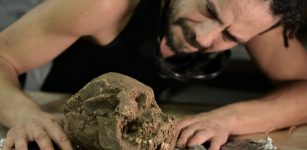 Lady SAS – Ancient Skeleton Of Foreign Woman Found In Palenque – Who Was She?
Archaeology | Apr 11, 2023
Lady SAS – Ancient Skeleton Of Foreign Woman Found In Palenque – Who Was She?
Archaeology | Apr 11, 2023 -
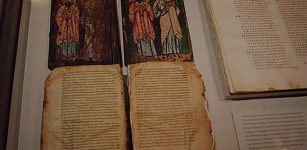 Codex Washingtonianus Contains A Passage Not Seen In Any Other Biblical Manuscript
Artifacts | Aug 4, 2015
Codex Washingtonianus Contains A Passage Not Seen In Any Other Biblical Manuscript
Artifacts | Aug 4, 2015 -
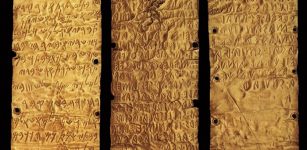 Pyrgi Gold Tablets: A Rare Ancient Bilingual Treasure
Artifacts | Nov 23, 2018
Pyrgi Gold Tablets: A Rare Ancient Bilingual Treasure
Artifacts | Nov 23, 2018 -
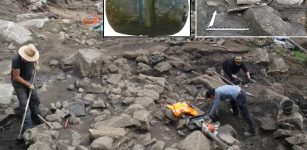 6,000-Year-Old Vast Settlement With Tools And Granite Structures Unearthed In Sotta, Corsica In France
Archaeology | May 16, 2023
6,000-Year-Old Vast Settlement With Tools And Granite Structures Unearthed In Sotta, Corsica In France
Archaeology | May 16, 2023 -
 World’s Oldest Dictionaries Are 4,500-Year-Old Cuneiform Tablets Discovered In Ebla
Ancient History Facts | Aug 19, 2016
World’s Oldest Dictionaries Are 4,500-Year-Old Cuneiform Tablets Discovered In Ebla
Ancient History Facts | Aug 19, 2016


